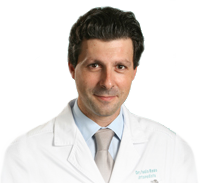- /
- Técnicas cirúrgicas /
- Luxação cirúrgica da anca
Surgical hip dislocation
The technique which has allowed an understanding of several mechanisms of the hip pathology and its treatment is called surgical hip dislocation.
Contrary to what may seem being an "open" surgery it is not too invasive, quite the contrary, allows full access to the hip joint and additionally perform other procedures, without causing any harm to muscles and hip tendons. Fully preserves the blood supply to the femoral head.
The surgery is extremely versatile and allows to treat nearly the whole pathology of the hip including femoroacetabular impingement, acetabular cavity fractures, diseases of the infant hip (with a few more complex additional procedures) (see section "Child hip").
It can also be used for placement of prostheses.
The surgical procedure requires specific instruments, specially designed to that effect.
The patient lies in a lateral position throughout surgery and usually requires a team larger than in other surgeries, due to the complexity of the procedures performed. Observing mobility with the exposed hip the surgeon tests all movements and is able to diagnose situations of mechanical anomaly often not apparent in radiographs taken before surgery. This possibility makes the technique highly effective in solving problems related to anatomical bone changes, tendon, muscles, cartilage and labrum. Access to the articulation is complete, including the posterior and inferior areas not accessible by arthroscopy. It is particularly indicated in more complex forms of femoroacetabular impingement and significant deformities of the femur or acetabulum (fig. 4 e 5).
Of this technique forms part an osteotomy (bone cut) of the greater trochanter enabling access to deeper levels of the hip while fully respecting all structures (fig. 1a,b and c). Once the articulation is exposed, the femur is dislocated from the acetabulum, with possible correction of all bone changes without exception (fig. 2 and 3). At the end of surgery, all of the structures are reset and the osteotomy of the trochanter is fixed with two or three screws in its original position or lower to improve the function of the hip muscles (see section "Proximal femur deformities").
The recovery from this surgery typically involves a hospital stay of 3 days and need to use crutches for about 4 weeks. The resumption of work varies widely, occurring on average within 6 to 8 weeks. Impact sports should only be allowed past a few months.
In the case of complex acetabulum fractures, the possibility to dislocate the hip in total safety allows treatment with full view of the articular surface (fig. 3, 4 e 5).
As the arthroscopy, this surgical technique is greatly demanding and has a long learning curve.
Ir should preferably be carried out by surgeons’ with expertise in hip preserving surgery.
| fig 1a: The skin incision is made on thelateral side of the thigh; surface structures are exposed |
| fig 1b: A osteotomia do trocânter permite expor a cápsula articular (cinzento) sem danificar as fibras musculares e com protecção activa da irrigação arterial da cabeça do fémur (see section "The normal child and adolescent hip"). |
| figura 1c: A anca é desarticulada com acesso total as estruturas intra-articulares permitindo o tratamento de todo o tipo de deformidades (cabeça do fémur, cavidade acetabular e labum). |
fig. 2: deformidade tipo “cam” de grandes dimensões. A exposição com a luxação cirúrgica da anca permite a correcção total de forma extremamente precisa. Na figura observamos uma correcção na região anterior, mas em determinados casos é necessária também correcção posterior. |
fig. 3: retroversão acetabular. A cirurgia permite a correcção precisa com remoção de parte da parede anterior e reinserção do labrum acetabular com fixação ao osso |
| fig. 4: deformidade extensa da cabeça femoral anterior e posterior num jovem de 16 anos, inacessível por artroscopia. Após cirurgia (imagem da direita) observamos a regularização de todo o contorno da cabeça femoral com bom resultado funcional. | |
| fig. 5: “coxa profunda” bilateral com cobertura excessiva da cabeça femoral numa doente de 28 anos. Após cirurgia (imagem da direita) observamos plastia extensa do acetábulo, permitindo aumentar a mobilidade das ancas e desta forma melhorar a qualidade de vida. Repare-se na correcção das linhas correspondentes ás paredes do acetábulo. Na anca direita foram retirados os parafusos que ainda se observam à esquerda. | |
| Fig. 6: Planeamento do tratamento de uma fractura complexa da cavidade acetabular. |
| fig. 7: A fractura da anca direita da cavidade acetabular com elevado grau de complexidade tratada com a técnica da luxação cirúrgica da anca. Conseguida uma reposição completa da anatomia normal. | |
| fig. 8: Na radiografia da esquerda observamos uma lesão traumática da anca de gravidade acrescida: fractura da parede posterior do acetábulo e simultaneamente da cabeça do fémur (seta vermelha e amarela respectivamente). À esquerda a mesma anca depois do tratamento utilizando esta técnica. A anatomia pode ser restituída integralmente melhorando muito o prognóstico. | |
Legal Notice
CirurgiaConservadoradAnca.com has been developed for the purpose of providing information on the various hip pathologies to patients, physicians and other healthcare professionals. The information contained in this website cannot replace a proper clinical assessment. May not in any way be used to make a diagnosis or suggest treatment. This website has no interest or is in any way associated with companies that sell medications or surgical equipment.
The content of the website is for informative purposes only and its use is the sole responsibility of users.
All submitted content is intelectual property of the author. It is expressly forbidden to copy and use without permission of the same.
It is not allowed to make connections to this website as well as framing, mirroring and link directly to specific subpages (deep linking) without the prior written consent of CirurgiaConservadoraAnca.com

